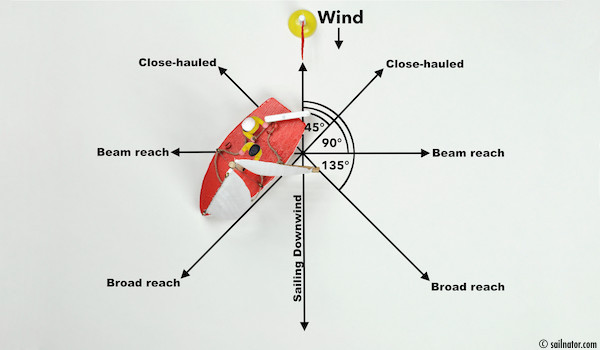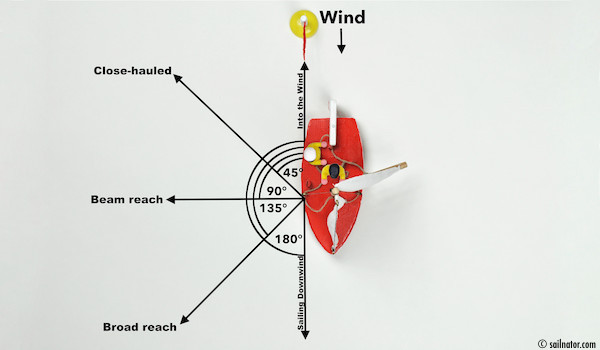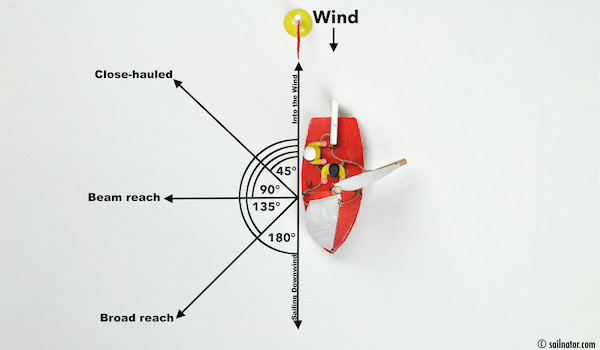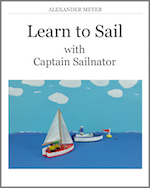In the last chapter we learned about the point of sail broad reach. Now we want to see what happens, when we keep on bearing away. The next course is called sailing downwind or running. The sails have to (you might have guessed it) be opened even more, as wide as possible. Because the jib comes into the wind shadow of the main just when we leave broad reach, (Figure 35) the crew has to pull it to the other side. (Figure 36)

Figure 34: Command: “Ease sheets for sailing downwind!” and bear away carefully.

Figure 35: The jib collapses in the wind shadow of the mainsail.

Figure 36: Commands: “Trim sails!” and: “Sailing downwind!”
So we sail with the wind in our back. It looks a little bit like a butterfly and some call it that. Others call it goose wing. The wind blows into the maximum available sail area and pushes the boat forward. Is this now the fastest course we can sail … ? Just think about it for a moment. No, it is possible to go faster.
 This online sailing course has also been published as ebook and paperback. For more information click here!
This online sailing course has also been published as ebook and paperback. For more information click here!
You can download the Ebook for example at:
iTunes UK & iTunes US | iBooks for iPad and Mac
Amazon.com & Amazon.co.uk | Kindle-Edition
Google Play | for Android
The paperback is available for example at:
Amazon.com | Amazon.co.uk
By sailing downwind the true wind pushes the boat from behind. But we have to factor in the wind of motion. And that actually presses against the sails from the front. The whole thing is not very aerodynamic. The fastest course is somewhere between beam reach and broad reach. That depends on the type of the boat and its design. Even though the wind comes only diagonally from behind, the wind of motion can better slip past the sails as when sailing downwind.
The danger when sailing downwind is the so called accidentally jibe. That is a jibe that is unplanned and not wanted. By jibing we go through the wind with the stern from broad reach to broad reach on the opposite side of the wind rose. You have to do that in a safer way, as I will explain in a later chapter.
When jibing accidentally the helmsman bears away too far and the boat already moves with the stern through the wind. The wind suddenly comes from the other side and the wide open mainsail blasts from one side to the other side, an angle of up to 180°. Should someone have his head in this area, he would be lucky to get away with only a bump. The boom crashes into the shroud and might damage the rig. In extreme case dismasting is possible. There is a risk of capsizing.
You are safe sailing downwind, when close to the edge, just there where the jib starts to collapse again. That is a kind of safety buffer in case the wind direction changes slightly. That is how slight mistakes by steering are often called. Especially with swell sailing downwind is not easy. In any case the heads should stay below the boom.
Watch again my stop motion video about the points of sail with Jenny and Tom →
The commands for sailing downwind are: “Ease sheets for sailing downwind!” “Trim sails!” “Sailing downwind!” When we want to head up again the command is … ? Exactly: “Sheet in to beam reach!” “Sailing beam reach!”
So what have we learned thus far? Sailing directly into the wind is impossible. The side closer to the wind is … ? Right, windward. The side the wind blows towards is … ? Right, leeward. To steer away from the wind is … ? Right, bear away. For that we do what with the tiller … ? Right, we pull it towards us. To steer closer towards the wind is called … ? Right, head up. For that we do what with the tiller … ? Exactly, we push it away from us.
The points of sail are called:
Close-hauled, Close reach, Beam reach, Broad reach, Sailing downwind or Running.
In the next chapter I explain how to turn the bow through the wind, which is called tacking.
← Last chapter | Next chapter →
All chapters: Technical Terms | The theory behind sailing |Close-hauled | Beam reach | Broad reach | Sailing downwind | Tacking | Beating | Quick-turn | Sailing up head to wind | Man overboard | Jibing | Heaving-to | Leaving the dock | Berthing | Rules of the road 1 | Rules of the road 2 | Rules of the road 3 | Reefing | Capsizing